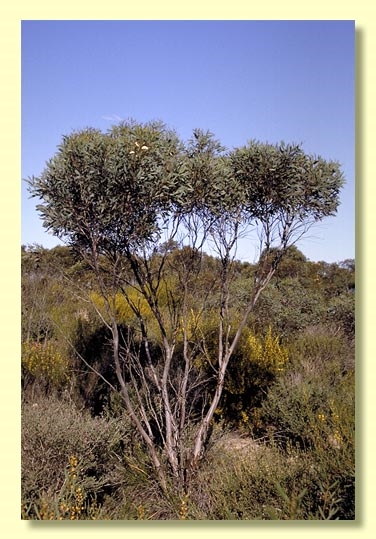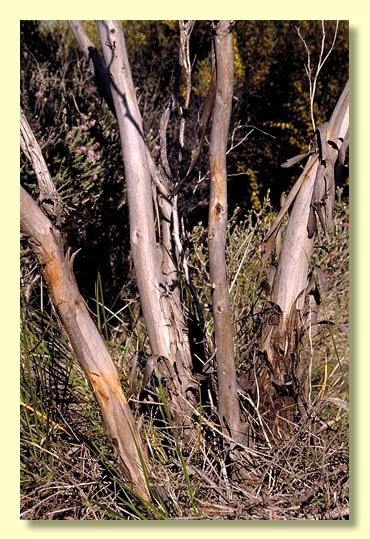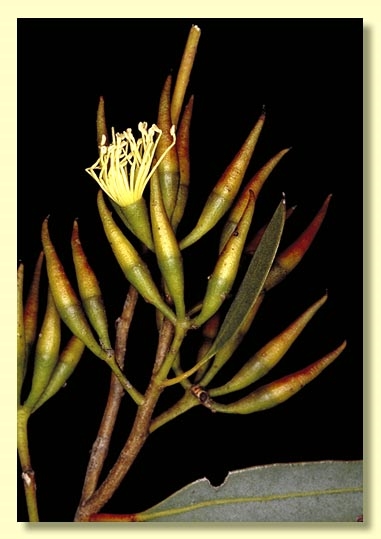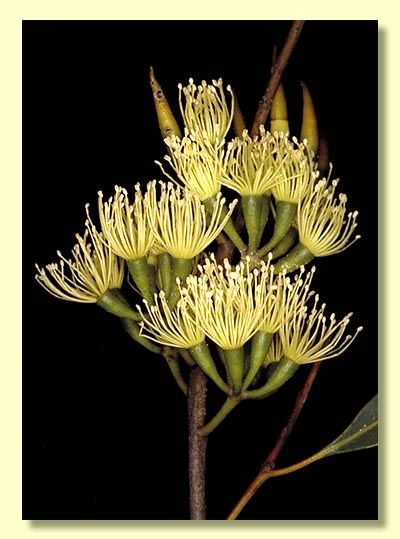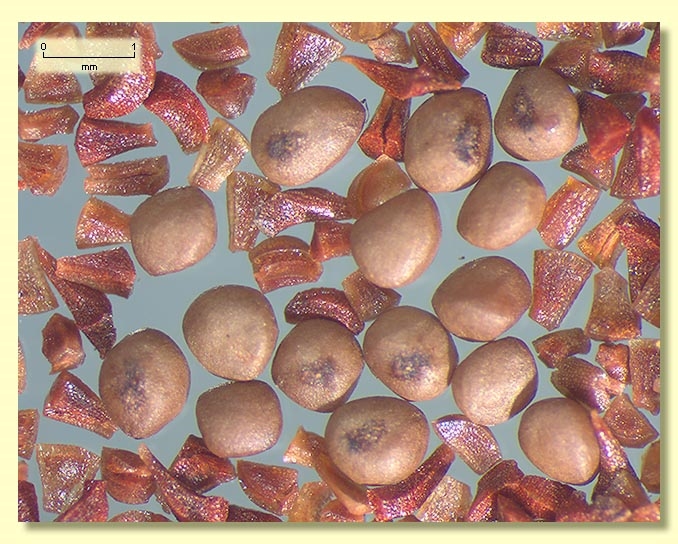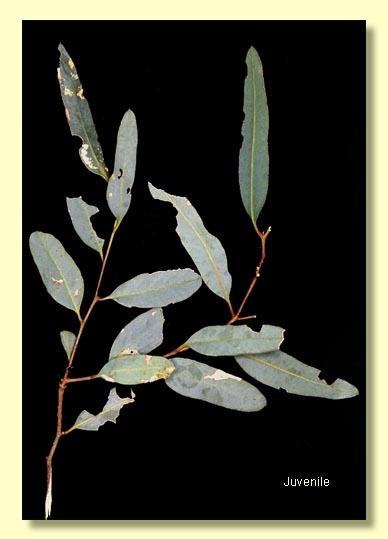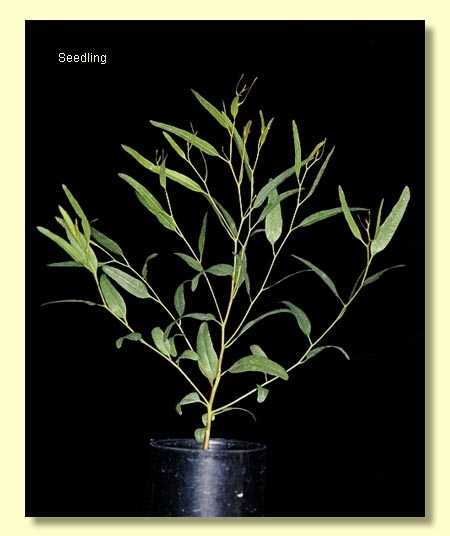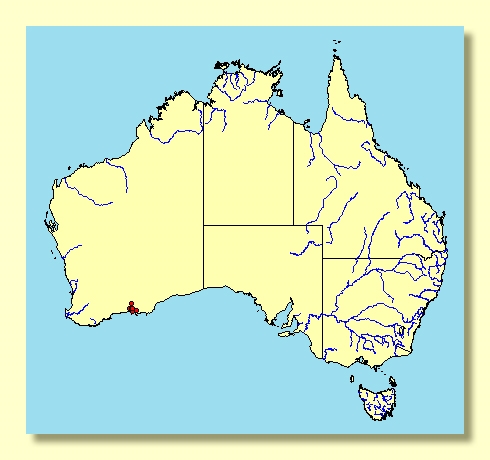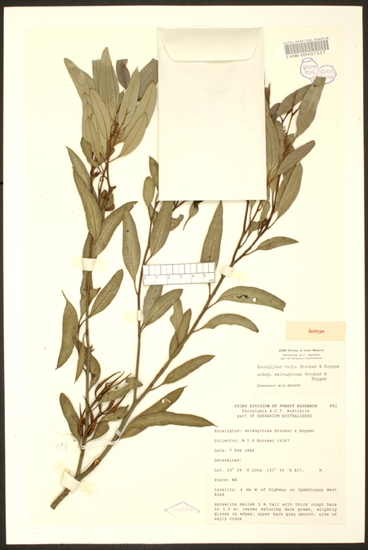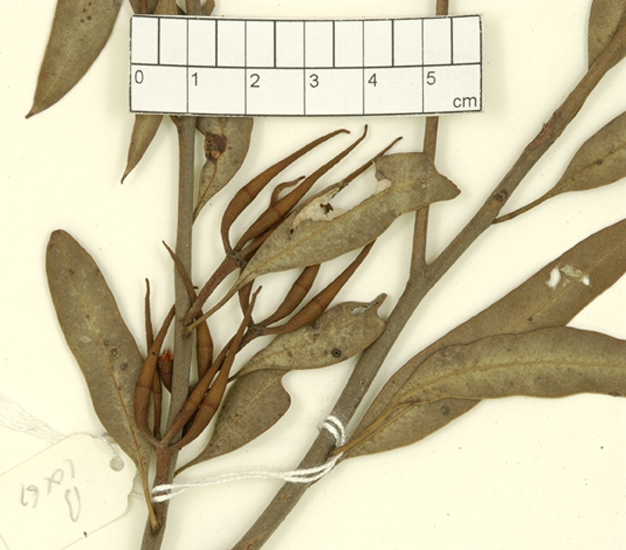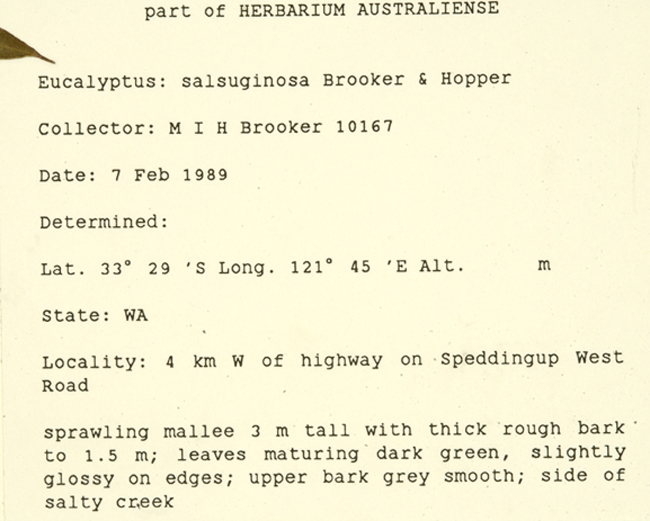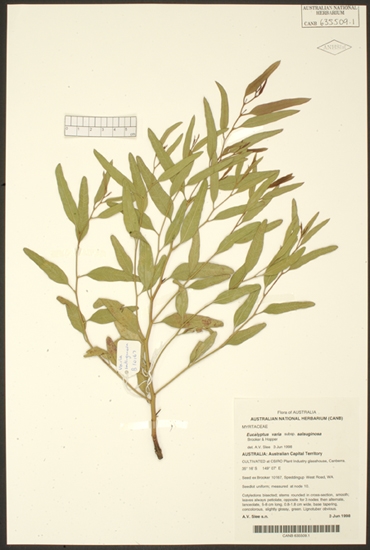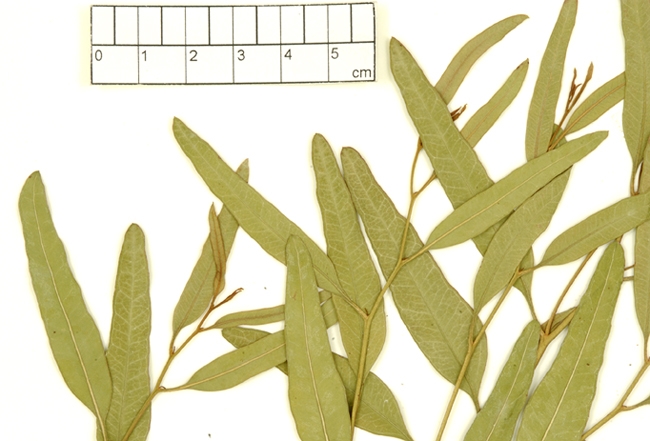Eucalyptus | Symphyomyrtus | Bisectae | Glandulosae | Levispermae | Levispermae
Euclid - Online edition
Eucalyptus varia subsp. salsuginosa
Classification
Nomenclature
Description
Mallee to 4 m tall. Forming a lignotuber.
Bark rough, thick, fibrous, greyish for up to 1.5 m of trunk, smooth above, grey-brown and pinkish, rarely smooth throughout on depauperate plants.
Branchlets usually lacking pith glands, rarely 1 or 2 present at nodes.
Juvenile growth (coppice or field seedlings to 50 cm): stems rounded in cross-section; juvenile leaves always petiolate, opposite at lowest nodes only then alternate, narrowly lanceolate, 4–6.5 cm long, 0.7–1.5 cm wide, dull, grey-green to green.
Adult leaves alternate, petioles 0.5–1.2 cm; blade narrowly lanceolate, 5–8.3 cm long, 0.5–1.5 cm wide, base tapering to petiole, margin entire, apex pointed, concolorous, dull and bluish green maturing slightly glossy and green inside the crown, side-veins greater than 45° to midrib, reticulation moderate to dense, intramarginal vein usually remote from margin, oil glands mostly island.
Inflorescence axillary unbranched, peduncles widening apically, 1–1.7(2) cm long, buds ?9 or 11, pedicellate (pedicels 0.3–0.5 cm long). Mature buds long-fusiform and slightly curved (1.6–2.3 cm long, 0.3–0.4 cm wide), scar present, operculum horn-shaped, three times the length of the hypanthium and equal to it in width at the join, few outer stamens erect, most stamens variably deflexed, anthers oblong, dorsifixed, dehiscing by longitudinal slits, style long and straight, stigma blunt to rounded, locules 3, the placentae each with 4 vertical rows of ovules. Flowers lemon.
Fruit pedicellate (0.2–0.6 cm long), barrel-shaped to cylindrical, 0.8–1 cm long, 0.5–0.6 cm wide, disc descending vertically, valves 3, at rim level or enclosed.
Seeds pale brown or straw-coloured, 0.8–1.6 mm long, usually sub-spherical to rounded-cuboid, surface smooth, hilum ventral/terminal.
Cultivated seedlings (measured at node 10): cotyledons Y-shaped (bisected); stems rounded in cross-section; leaves always petiolate, opposite for ca 3 nodes then alternate, lanceolate, 5–8 cm long, 0.8–2 cm wide, green.
Bark rough, thick, fibrous, greyish for up to 1.5 m of trunk, smooth above, grey-brown and pinkish, rarely smooth throughout on depauperate plants.
Branchlets usually lacking pith glands, rarely 1 or 2 present at nodes.
Juvenile growth (coppice or field seedlings to 50 cm): stems rounded in cross-section; juvenile leaves always petiolate, opposite at lowest nodes only then alternate, narrowly lanceolate, 4–6.5 cm long, 0.7–1.5 cm wide, dull, grey-green to green.
Adult leaves alternate, petioles 0.5–1.2 cm; blade narrowly lanceolate, 5–8.3 cm long, 0.5–1.5 cm wide, base tapering to petiole, margin entire, apex pointed, concolorous, dull and bluish green maturing slightly glossy and green inside the crown, side-veins greater than 45° to midrib, reticulation moderate to dense, intramarginal vein usually remote from margin, oil glands mostly island.
Inflorescence axillary unbranched, peduncles widening apically, 1–1.7(2) cm long, buds ?9 or 11, pedicellate (pedicels 0.3–0.5 cm long). Mature buds long-fusiform and slightly curved (1.6–2.3 cm long, 0.3–0.4 cm wide), scar present, operculum horn-shaped, three times the length of the hypanthium and equal to it in width at the join, few outer stamens erect, most stamens variably deflexed, anthers oblong, dorsifixed, dehiscing by longitudinal slits, style long and straight, stigma blunt to rounded, locules 3, the placentae each with 4 vertical rows of ovules. Flowers lemon.
Fruit pedicellate (0.2–0.6 cm long), barrel-shaped to cylindrical, 0.8–1 cm long, 0.5–0.6 cm wide, disc descending vertically, valves 3, at rim level or enclosed.
Seeds pale brown or straw-coloured, 0.8–1.6 mm long, usually sub-spherical to rounded-cuboid, surface smooth, hilum ventral/terminal.
Cultivated seedlings (measured at node 10): cotyledons Y-shaped (bisected); stems rounded in cross-section; leaves always petiolate, opposite for ca 3 nodes then alternate, lanceolate, 5–8 cm long, 0.8–2 cm wide, green.
Flowering Time
Flowering time unknown.
Notes
Eucalyptus varia is a species of mallee endemic to Western Australia, found north-west of Esperance extending east towards Condingup. The adult leaves are dull, light bluish green to green but mature inside the crown to glossy green.
Eucalyptus varia is a somewhat anomalous species in Eucalyptus subgenus Symphyomyrtus section Bisectae subsection Glandulosae, because whilst the cotyledons are bisected and the buds have an operculum scar, as do other species in this group, the branchlets usually lack the characteristic pith oil glands or have very few. Within this subsection E. varia is one of a group of species that form series Levispermae subseries Levispermae characterised by having smooth spherical seed, a peduncle that widens apically, buds that are narrowly fusiform with some stamens erect and others variably deflexed, usually dull, blue-grey to grey-green adult leaves, and few, if any, oil glands in the pith.
E. varia is closely related to E. pluricaulis but occurs further to the east. E. varia differs in adult leaves that are generally smaller (although there is considerable overlap in leaf dimensions between the two species). Leaves of E. varia are greener than those of E. pluricaulis. The low coastal mallee E. redunca is also closely related to E. varia and differs in its persistently dull green adult leaves, often longer buds (though the dimensions are not discrete) and paler lemon flowers.
In the geographic range of E. varia the only species likely to be confused is E. tumida, which has oil glands in the pith of the branchlets, fatter buds that never taper to a long fine point as do both E. varia and E. pluricaulis. E. tumida also has broader, slightly glossy adult leaves and flowers that are white to very pale yellow, not distinctly yellow.
There are two weakly separated subspecies:
E. varia subsp. varia
Smooth-barked form. Subsp. varia occurs on sandplains or lateritic slopes from the Dalyup area north west of Esperance east to the Thomas River north of Cape Arid.
E. varia subsp. salsuginosa
This form has some basal, fibrous, rough bark and occurs on salt drainage lines and seasonally wet flats north and north-west of Esperance, particularly on tributaries of the Dalyup River, eastwards to Speddingup East.
Eucalyptus varia is a somewhat anomalous species in Eucalyptus subgenus Symphyomyrtus section Bisectae subsection Glandulosae, because whilst the cotyledons are bisected and the buds have an operculum scar, as do other species in this group, the branchlets usually lack the characteristic pith oil glands or have very few. Within this subsection E. varia is one of a group of species that form series Levispermae subseries Levispermae characterised by having smooth spherical seed, a peduncle that widens apically, buds that are narrowly fusiform with some stamens erect and others variably deflexed, usually dull, blue-grey to grey-green adult leaves, and few, if any, oil glands in the pith.
E. varia is closely related to E. pluricaulis but occurs further to the east. E. varia differs in adult leaves that are generally smaller (although there is considerable overlap in leaf dimensions between the two species). Leaves of E. varia are greener than those of E. pluricaulis. The low coastal mallee E. redunca is also closely related to E. varia and differs in its persistently dull green adult leaves, often longer buds (though the dimensions are not discrete) and paler lemon flowers.
In the geographic range of E. varia the only species likely to be confused is E. tumida, which has oil glands in the pith of the branchlets, fatter buds that never taper to a long fine point as do both E. varia and E. pluricaulis. E. tumida also has broader, slightly glossy adult leaves and flowers that are white to very pale yellow, not distinctly yellow.
There are two weakly separated subspecies:
E. varia subsp. varia
Smooth-barked form. Subsp. varia occurs on sandplains or lateritic slopes from the Dalyup area north west of Esperance east to the Thomas River north of Cape Arid.
E. varia subsp. salsuginosa
This form has some basal, fibrous, rough bark and occurs on salt drainage lines and seasonally wet flats north and north-west of Esperance, particularly on tributaries of the Dalyup River, eastwards to Speddingup East.
Origin of Name
Eucalyptus varia: Latin varius, varying, referring to the variable stature, bark, adult leaf width, and habitat.
subsp. salsuginosa: Latin salsuginosus, in brackish places, referring to the saline habitat occupied by the subspecies.
subsp. salsuginosa: Latin salsuginosus, in brackish places, referring to the saline habitat occupied by the subspecies.
Copyright © CANBR 2020, all rights reserved.

Web edition hosted at https://apps.lucidcentral.org/euclid
